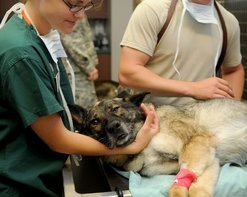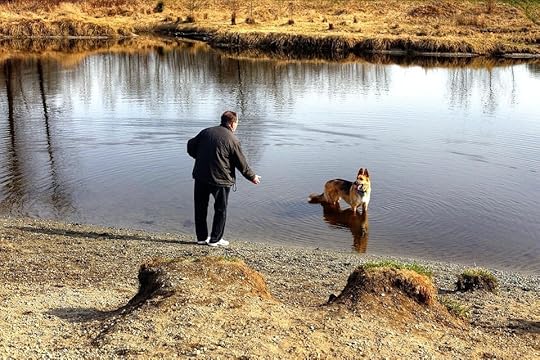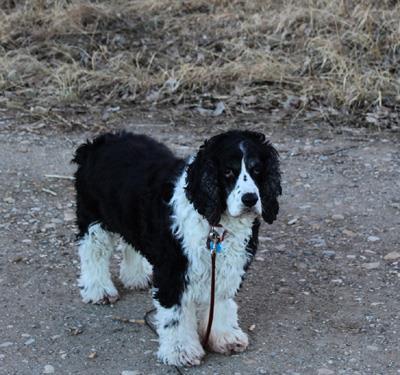Gayle Irwin's Blog, page 23
February 21, 2017
4 Reasons to Spay or Neuter Your Pet
 February is Spay/Neuter Awareness Month and the last day of the month is considered World Spay Day. Every year millions of dogs and cats, puppies, and kittens go into animal shelters, and sadly, a lot of them die in those shelters. If more companion animals were spayed or neutered, the number of litters of puppies and kittens would decrease, and therefore, so, too, would the numbers of animals killed in shelters each year.
February is Spay/Neuter Awareness Month and the last day of the month is considered World Spay Day. Every year millions of dogs and cats, puppies, and kittens go into animal shelters, and sadly, a lot of them die in those shelters. If more companion animals were spayed or neutered, the number of litters of puppies and kittens would decrease, and therefore, so, too, would the numbers of animals killed in shelters each year.That is one reason to spay and neuter pets. There are several others.
Healthier Pets. According to a story written a few years ago in USA Today, the states with the healthiest pets also had the largest number of animals that were spayed/neutered. The two top states for both, healthy pets and altered pets, were Colorado and Montana. Experts at the ASPCA (American Society for the Prevention of Cruelty to Animals) note that fixing a dog or cat helps to prevent uterine infections and breast tumors, which are malignant or cancerous in about 50 percent of female dogs and 90 percent of female cats and also prevents testicular cancer and some prostate problems in male dogs and cats.Curbs Behavioral Issues. Female companion animals are known to urinate more often in the house and walk around howling and yowling when in heat, and males are known to leave the house and roam the neighborhood – spaying and neutering take care of these issues.Protects Pets from Accidental Death. When pets roam, they can engage in fights with other animals, be bitten by wildlife like skunks which may carry rabies, or be hit by cars. According to the SpayUSA organization, up to 85% of dogs hit by cars are unaltered, and intact male cats that live outside may, on average, live less than two years.Saves Community Taxpayer Dollars. According to the American Veterinary Medical Association, “the capture, impoundment and eventual destruction of unwanted animals costs taxpayers and private humanitarian agencies over a billion dollars each year.”
Although a spay surgery can be expensive, especially for a large or extra-large female dog, there are opportunities to find low-cost spay-neuter clinics. The ASPCA provides a database of such low-cost clinics. Visit their webpage at http://www.aspca.org/pet-care/general-pet-care/low-cost-spayneuter-programs to find a clinic/program near you. The Humane Society of the United States can also assist you finding low-cost programs and clinics; visit that group’s website to learn more: http://www.humanesociety.org/issues/pet_overpopulation/tips/afford_spay_neuter.html?credit=web_id88387650.
If you live in Wyoming, as I do, you can visit the SpayWyoming page, a state-wide program of the Dog and Cat Shelter in Sheridan, Wyoming and an affiliate of SpayUSA. You might also visit the Care Credit website, a health-care credit card covering dental, chiropractic, veterinary, and other medical fields; the company often gives patients (or in this case the “pet parents” of patients) six to 12 months to pay off the account before charging interest (it’s a program my husband and I use for our veterinary bills).
The outlay for a spay or neuter might be spendy at first, especially if your area doesn’t have a low-cost spay/neuter program. However, the benefits of the surgery are many, including a healthier pet and not dealing with behavioral issues. But, a strong reason to spay and neuter is saving lives, not having to wonder how to find homes for litters of puppies and kittens and facing the reality that, if taken to an animal shelter, those animals may not get new homes, but instead, may die.
Please do your part as a responsible pet parent: spay/neuter your companion animal!

Published on February 21, 2017 17:16
February 13, 2017
You Can Adopt a Purebred Dog Through Rescues and Shelters
 The Westminster Dog Show is underway this week, so it’s a good time to remember that you don’t have to go to a breeder to find great dogs; you can find purebred dogs, as well as mixed breeds, available for adoption through shelters and rescues.
The Westminster Dog Show is underway this week, so it’s a good time to remember that you don’t have to go to a breeder to find great dogs; you can find purebred dogs, as well as mixed breeds, available for adoption through shelters and rescues.Not all breeders are bad; in fact, those registered through the American Kennel Club (AKC) must meet high quality standards. However, the facts remain that millions of dogs are turned into rescues and shelters every year, and of the four million that go into shelters, more than one million don’t come out – meaning, they die. And breeding dogs add to the pet overpopulation problem, which adds to the number of dogs euthanized every year.
It’s estimated that between 5 and 25 percent of dogs placed in shelters are purebred. Recently at my community’s humane society a long-haired, tri-colored collie came in because its aging owner could no longer take care of it. And, last fall two shih tzus were brought into the kill-shelter in my town, which is operated by the city; both had been used as breeders – one was 12 years old and not spayed. So, although good breeders do exist, so do bad breeders. That doesn’t mean the dogs are bad, they are just not as well-cared for, and many of them end up in shelters and rescues. In fact, the mission of National Mill Dog Rescue (NMDR) is to bring into rescue those dogs which are used in what’s known as puppy mills – backyard breeders whose priority is profit and who often shove these creatures into tiny cages. Through NMDR, these adorable animals, from small Maltese to large German Shepherds, are socialized, loved on, given medical care, and made available for adoption.
Other rescue groups, such as Big Dogs Huge Paws that specialize in rescue and re-homing the larger dog breeds, such as Great Danes, Mastiffs, and Newfoundlands, and English Springer Rescue America, with chapters around the nation, take in specific breeds that need new homes. Even the AKC endorses breed-specific rescues – learn more at http://www.akc.org/dog-breeds/rescue-network/contacts/.
If you’re thinking of adopting a dog and aren’t sure what breed is right for you, watching this week’s Westminster Dog Show is a great way to learn about the various breeds. You can also review breed traits, personalities, and behavior patterns by reading up on the different types of dogs at this website: http://www.akc.org/dog-breeds/. One of the most responsible things a person can do before obtaining a dog, whether through adoption or purchasing from a breeder, is to learn what type of dog best fits your lifestyle and desires. Do your homework before bringing a dog home!
The most popular type of dog in America is the Labrador Retriever; it is also among the top five most common breeds found in animal shelters (or lab mixes); black labs are also among the least likely to be adopted because the coat color tends to blend in with the dark surroundings of many animal shelters. And though Labs are popular, not one has ever taken Best in Show at Westminster. Neither has the Golden Retriever, Dachshund, or Chihuahua, all of which are also very popular breeds. Perhaps one of those will win this year. Stay tuned!
Wondering where to catch the dog show of dog shows? Visit http://www.sportingnews.com/other-sports/news/westminster-dog-show-2017-tv-channel-schedule-online-stream-coverage/n9nwcw6efxf16ki6f5eeqk5g to learn which TV stations are carrying this special event.
And remember two important things the next time you’re looking for a specific dog breed as a companion: (1) do your research on dog breeds and (2) adopt, don’t shop! One of the best ways to find a certain breed of dog, in addition to the earlier-mentioned resources, is to go to Petfinder.com – you can search for a specific dog breed, even sex and age, that is available through a local, regional, or national rescue or shelter.

Published on February 13, 2017 05:30
February 7, 2017
Assistance Animals Give a Helping Paw
 In 2012, I wrote the article found below for a local publication. I am posting it to my blog today in honor of Luis Carlos Montalvan, former Army captain, author, and advocate for American veterans, especially those suffering from PTSD. Luis died in December; I learned about his passing just last week.
In 2012, I wrote the article found below for a local publication. I am posting it to my blog today in honor of Luis Carlos Montalvan, former Army captain, author, and advocate for American veterans, especially those suffering from PTSD. Luis died in December; I learned about his passing just last week.I followed him on Facebook and several years ago, had the honor of meeting him in person. Luis had a service dog named Tuesday, who received the 2013 American Kennel Club ACE Award (Awards for Canine Excellence). The two visited my local library after the release of Luis’ book Until Tuesday. Their story is moving and I was honored to have met them in person and later to follow Luis (and Tuesday) on Facebook. In their honor, I post this article published November 2012 in Our Town Casper magazine:
I recently finished reading an incredible book, Until Tuesday: A Wounded Warrior and the Golden Retriever Who Saved Him. I was privileged to meet and briefly speak with author and former Army Captain Luis Carlos Montalvan. Listening to Captain Montalvan, witnessing his service dog, Tuesday, and then reading about them in Luis’ book, touched my heart and soul. I’ve met a few service dogs and their human partners in times past; coupled with Captain Montalvan’s recent presentation and reading about him and Tuesday in the book, I possess a deeper appreciation for the service that assistance animals provide – as well as a deeper understanding about the horrors of war and the affects upon our service men and women.
In light of Veteran’s Day and my encounters with Luis, Tuesday and their story, I spent a bit of time researching and learning about animal assistance programs for veterans. The U.S. Department of Veterans Affairs will pay for guide dogs for blind veterans, hearing dogs for the hearing impaired, and assistance dogs for veterans with other physical disabilities. However, the agency ruled in September that it would not pay for service dogs for veterans suffering from PTSD (Post Traumatic Stress Disorder) – see link: http://usnews.nbcnews.com/_news/2012/09/06/13708645-va-wont-cover-costs-of-service-dogs-assigned-for-ptsd-treatment. Yet, it will provide (and prescribe) nearly any type of pharmaceutical drug for treating mental and emotional distress.
Scientific studies show people with pets are less prone to depression, are more active physically, and have lower blood pressure and cholesterol. Dogs, cats and other animals trained as therapy pets visit nursing homes and hospitals and help lessen anxiety among those with whom they spend time. Emotional support animals (ESA) are used with people who have an emotional disability, and can be prescribed by a licensed mental health provider (learn more at the National Service Animal Registry website: http://www.nsarco.com/emotionalsupportanimals.html).
Our wounded warriors can use such assistance. The Pentagon reported earlier this year that suicide among American active-duty military personnel rose to an average of one per day. Additionally, according to the Army Times in 2010, about 18 veterans each day committed suicide. It’s estimated that 30 to 40 percent of veterans suffer from PTSD. These are startling, and scary, statistics.
Capt. Montalvan suffers from PTSD as well as remnants from traumatic physical injuries to his brain and vertebrae from an incident in Iraq. He also experienced nightmares, sleeplessness, hypervigilance, and isolation, common threads in PTSD.
Although his condition improved after being partnered with Tuesday, his service dog, Montalvan will never be completely healed, either physically or emotionally. He relies on Tuesday to get through his days and his nights. Tuesday is trained to respond to Luis’ needs, the physical and the emotional. Tuesday provides Luis balance, steadying him on the bumpy, concrete sidewalks and helping him navigate stairs (Luis walks with a cane). Tuesday provides Luis balance emotionally as well, navigating the signals of anxiety as they walk through towns and travel on subways or airplanes.
Luis admits in his book, “I don’t look exactly like a typical disabled person with a service dog.” And for that, he, and numerous others, have been and are discriminated against. Service animals who are trained to perform tasks to help disabled people wear a vest, often with the words “service animal” or “working animal” on them; there are laws which allow such animals into places where most typical “pets” are not: restaurants and other public buildings, airplanes and public transportation, housing. However, Luis recounts numerous times the discrimination he encountered.
Although Emotional Service Animals are not always allowed in the same places as certified assistance animals, there are federally protected rights for these animals and their human partners, including flying on an airline not being allowed into “no pet policy” housing.
I am grateful those who need such physical or emotional service can and do receive that. Numerous others do not. May this Veteran’s Day be the eye-opener we need to recognize and honor those service men and women who have lost limbs, experienced traumatic brain injury and PTSD, or perhaps even suffer silently yet can greatly benefit from the devotion and care a service animal provides. Our wounded warriors deserve whatever medical treatment suits them best… and sometimes that’s lick in the face or a paw on the knee from a four-footed creature that adores (and sacrifices) for them.
If interested in learning more about Captain Montalvan and Tuesday, visit: http://until-tuesday.com/.
From the Blogger/Author: Although Luis has passed, an upcoming book will continue his and Tuesday’s legacy. Tuesday’s Promise is scheduled for release in May. Tuesday, now 10 years of age, is being cared for by the organization that brought them together: Educating Canines Assisting with Disabilities (ECAD). If you are so inclined as I was, you can make a donation in Luis’ memory and Tuesday’s honor at this website: https://connect.clickandpledge.com/w/Form/9f980d6d-5bbf-4162-be1c-3821bc674d0f
Published on February 07, 2017 05:30
January 31, 2017
Pet Adoption: Is it Time?
 A little more than a year ago, my husband and I lost our nearly 18-year-old cocker spaniel named Cody. We had adopted him when he was almost 10 years of age. He had been used as a stud dog for a breeder and then basically tossed away like yesterday’s garbage. When we discovered him at our local humane society, his sad spaniel eyes ignited my heart. Even though he likely wouldn’t be with us but a few years, we determined to give him the best couple of years of his life. Two years turned into three, into five, into seven. At 17 ¾ years of age, Cody crossed the Rainbow Bridge, knowing he was loved, adored, and pampered to the very end.
A little more than a year ago, my husband and I lost our nearly 18-year-old cocker spaniel named Cody. We had adopted him when he was almost 10 years of age. He had been used as a stud dog for a breeder and then basically tossed away like yesterday’s garbage. When we discovered him at our local humane society, his sad spaniel eyes ignited my heart. Even though he likely wouldn’t be with us but a few years, we determined to give him the best couple of years of his life. Two years turned into three, into five, into seven. At 17 ¾ years of age, Cody crossed the Rainbow Bridge, knowing he was loved, adored, and pampered to the very end.Our hearts and home are more empty since his passing, but the nearly eight years we shared with Cody were filled with laughter, joy, and love.
We still have Mary, a springer-cocker mix we adopted four years ago this week. She was nearly seven when she came to live with us, and we credit Mary with helping keep Cody going as long as he did. They shared walks in the woods with us, trips to the dog park, and travels in the car, as well as cuddles on the couch and snuggles in bed. Their friendship was very special, especially considering they were not raised together.
Mary turns 11 next week. We’ve considered adopting another dog as she was raised with a smaller pup prior to her going into rescue at the death of her special person in 2012. She misses Cody; that was readily apparent in the early months after Cody’s passing. She is bonded to us, especially to my husband who often gets to work from home. When does a person know the right time to adopt a pet, whether one pet has passed or a person has never been the guardian of an animal before?
Just like with having kids, no time may be the actual “right time” to adopt, but one thing is for sure: a person must MAKE TIME to care for a pet properly. I would encourage anyone considering adopting a pet to make sure you have time to give, that your life is not so incredibly full that the animal will be left alone for countless hours and have little interaction with its human family. Too many animals are given up because of the excuse “I don’t have time for it.” Just as children need nurturing, attention, and care, so do our pets. They rely on us, they need us, and they want us to share time and activities with them.
So, if you’re thinking of adopting a pet, ensure you won’t change your mind in a month or so and say “I don’t have time.” First and foremost, make sure time is something you do have, or will make, before bringing a pet into your home.
And, if you think you can’t find the type of pet, the breed of dog or cat you want, think again: not all shelter pets are “mutts.” In fact, depending on where you live and what you’re looking for, 5 to 25 percent of shelter pets are purebred. Look on Petfinder.com for a specific breed, sex, and even whether they’re good with children or other animals. And, view this website for some of the types of dog breeds one is likely to find at shelters: https://mom.me/pets/19900-dog-breeds-commonly-found-animal-shelters/. Additionally, specific breed rescues can be found at this website: http://www.akc.org/dog-breeds/rescue-network/contacts/.
Is it time for my husband and I to adopt another dog? Not yet, but likely by the end of the year. I do look, and I do consider. And perhaps we’ll change our minds mid-year and adopt again at that time. We’ll know when the time is right – I believe you will, too for you and your family.

Published on January 31, 2017 04:00
January 24, 2017
3 Reasons Why Pets are Abandoned After Foreclosure
 In the midst of the mortgage and foreclosure crisis, our family pets can often be the unintended and forgotten victims. No family intends to leave behind their furry companions, as they can often provide comfort in times of stress and extreme change. There are generally extenuating circumstances that leave families feeling like they have no other option but to abandon their animals.
In the midst of the mortgage and foreclosure crisis, our family pets can often be the unintended and forgotten victims. No family intends to leave behind their furry companions, as they can often provide comfort in times of stress and extreme change. There are generally extenuating circumstances that leave families feeling like they have no other option but to abandon their animals. During the winter months especially, freezing weather brings additional concerns for pets left behind, as this recent social experiment in New York shows. Below are the three most common reasons pets are abandoned during a foreclosure; and the resources available for owners who need help.
Food and Care Bills
One of the biggest reasons families leave their pets after foreclosure is the inability to provide for food and care. Homeowners faced with foreclosure are not only unable to pay their monthly housing. By the time a foreclosure has occurred families will typically see bills for everything from utilities to groceries beginning to stack up. Providing food and veterinary care, especially in case of an emergency medical need, can seem like an impossible task to families.
Lack of Housing
Families in the midst of foreclosure will often be faced with difficult choices when it comes to housing. When being forced out of the home that they own, finding a rental property that accepts pets or a friend or family member that has room for the furry companion can be a challenge. Many rental properties have limitations on size, breed, and number of animals and can also charge hefty deposits that make bringing the pets along seem like an impossible task. Similarly, when relying on the compassion of friends or family homeowners can feel embarrassed or guilty regarding burdening their hosts with a pet, in addition to space concerns.
No Other Options
Pets are not intentional victims of neglect and abuse when it comes to foreclosures and abandonment. Losing your home is one of the most stressful life events a family will ever face. During this hectic and chaotic time, families often feel as if they have no other options. Turning their pet over to a shelter will often mean potential euthanasia in increasingly overcrowded and overtaxed local facilities. Abandoning a pet to care for itself is often seen as the better alternative when there is nowhere else to turn.
Help is Out There
What the public and families facing foreclosure need to realize is that help is out there and there are numerous resources available for families either seeking to find a new home for their pet or that need temporary financial or housing assistance in order to keep their companions with the family.
For families looking in need of temporary help, websites that offer dog boarding and dog sitting services, such as rover.com dogvacay.com or wagwalking.com, can be lifesavers. Few owners know that each of these sites offer off-location pet-sitting in addition to in home stays and can be used for extended periods of time such as during a physical move or transition into new housing. Long term rates can be very reasonable and will often be discounted, depending on your location. Local families or neighbors may also be willing to board your pet for a short period of time.
Local shelters and humane organizations may have financial assistance available for food or veterinary bills. Shelters or vet clinics in some locations may have vouchers on hand or a list of national or local organizations that will provide short term loans or grants in order to help you care for your pet during economic difficulties. If none of these quite fit your situation, there are a variety of online resources for families that need to find a reputable rescue organization to help place their pet in a new home.
To Sum Things Up…
In short, families facing foreclosure should never feel like they are alone in their struggles to care for both the human and animal members of their families. Leaving behind a family pet is never a decision that is made carelessly and is, instead, typically a result of the owner’s hands being forced when they believe they are out of options. Homeowners facing foreclosure should know that there are a variety of options available and that abandoning your pet should never be a decision you are forced to make.
 Author Bio:
Author Bio:
Simon Campbell has spent over 15 years in all the various facets having to do with real estate including sales, purchases, investment and research. Simon has changed directions and is now sharing his knowledge and experience with others to avoid foreclosure. For more details, check his website http://www.stopforeclosureshelp.com

Published on January 24, 2017 05:00
January 17, 2017
Foreclosure and Abandoned Pets
 Every year millions of dogs and cats go into animal shelters and pet rescues. “We’re moving,” is a primary reason given for leaving pets at animal shelters. Sometimes, however, when that move is due to a house foreclosure, the pets are simply left in the home and come to the attention of the bank or real estate broker when an inspection of the home is conducted.
Every year millions of dogs and cats go into animal shelters and pet rescues. “We’re moving,” is a primary reason given for leaving pets at animal shelters. Sometimes, however, when that move is due to a house foreclosure, the pets are simply left in the home and come to the attention of the bank or real estate broker when an inspection of the home is conducted.Leaving a pet behind is morally, and often legally, wrong, and can leave a pet not just confused and lonely, but also create behavior problems for it, making it less adoptable. If you must move and can’t take your pet, please contact your local animal shelter or pet rescue organization as soon as possible. Give your beloved, faithful furry companion the opportunity to find a new, loving home by trusting those organizations and people who give of themselves to find homes for needy animals.
If you are facing foreclosure or need to move for another reason, before leaving your animal behind or even with a rescue organization, read this informational guide produced by StopForeclosuresHelp.com – it provides tips and statistics helpful for people who are facing this problem and have animals that will need care. It also provides information for people who want to help abandoned animals. Visit the site for help and information: http://www.stopforeclosureshelp.com/how-to-help-abandoned-pets/.

Published on January 17, 2017 05:00
January 10, 2017
Resolutions for Us and Our Pets - Part 2: Exercise
 As noted in last week’s post, many people make resolutions for the New Year, and one of those is to get more exercise. Did you know our pets can help us with this endeavor? Dogs especially encourage people to be more active because most dogs also want to be active. From throwing Frisbees to pitching tennis balls, from walking to hiking, and from the kennel club arena to the backyard, there are many activities we can enjoy with our canine companions.
As noted in last week’s post, many people make resolutions for the New Year, and one of those is to get more exercise. Did you know our pets can help us with this endeavor? Dogs especially encourage people to be more active because most dogs also want to be active. From throwing Frisbees to pitching tennis balls, from walking to hiking, and from the kennel club arena to the backyard, there are many activities we can enjoy with our canine companions.A person can even take a cat for a walk on a leash, and playing feather toys or chase the laser pointer can engage our feline friends – and make us humans move as well.
Because there are so many varied and enjoyable activities for dogs and their humans, this article will focus on those. Here’s a short list of ways humans and their dog friends can enjoy exercise together (some are event American Kennel Club – AKC – sanctioned events):
Agility: this exciting, fast-paced activity showcases a dog’s intelligence and stamina as well as its connection to its owner. Agility events happen throughout the world and many are AKC recognized events. Learn more, including tips for starting your dog in agility, at http://www.animalplanet.com/pets/10-tips-dog-agility-training/.
Dock Diving: one of the fastest growing sports for dogs, this event open to canines that are not AKC-registered (through the North American Diving Dogs program); however, the AKC does recognize this activity.
Flyball: this relay race for dogs features four dogs on a team. The sport began several decades ago and continues to be a canine activity enjoyed by many people and their animals. Learn more at https://flyballdogs.com/FAQ.html.
Freestyle Musical Dance: a relatively new sport, this activity involves obedience and dance, with the handler and dog performing dance-oriented footwork in time to music. Learn more at http://www.dogscandance.com/.
Obedience: All dogs should have some obedience training. How far you want to take it is up to you –competition in obedience trials or just a dog who will obey commands during daily life. Either way, you and your dog will enjoy the benefits of better communication and an increased bond. Learn more at http://www.pet360.com/dog/behavior-and-training/can-dog-training-save-your-poochs-life/Oi_m4yZ6_EKJV1xasL9h0w.
Skijoring: a team sport between handler and dog, this activity involves skiing by the person and running by the dog(s). The canine(s) needs to be obedient and the activity takes a lot of practice. Learn more at http://www.petguide.com/petcare/dog/need-to-know-tips-getting-started-in-skijoring/.
Tracking: this canine sport showcases a dog's natural ability to recognize and follow a scent; it’s the foundation of canine search and rescue work and involves training dogs to use their highly-developed sense of smell through which they find lost humans or animals and/or detect drugs, bombs, and other things. This is also an AKC-recognized event. Learn more at http://www.akc.org/events/tracking/.
Other activities include AKC Rally a course sport, Flying Disc Dog, by which a dog captures a disc or Frisbee-like object in the air, EarthDog tests, a way to assess and engage terriers and other digging dogs’ ability to find and trap quarry, and Field Trials, through which hunting breeds like pointers, setters, and retrievers find game. There are also a variety of harness activities, from carting to dogsled mushing.
One doesn’t have to participate in Kennel Club-offered events nor have a purebred, registered pup. For example, tracking can be done in your backyard or the local park, in which you hide a smelly object, like peanut butter treats in a ball or an article of clothing (like a mitten stuffed with peanut butter) and have your dog find it – this can be done in the snow for an even greater challenge! Also, you can set up agility equipment in your yard and simply run your dog through a course. Play Frisbee with your dog or take him/her skiing, hiking, or running. There are many ways to engage your furry friend in a fun activity that you both can enjoy – and you both will get exercise along the way!
Find more information on fun activities to enjoy with your pet at http://bestfriends.org/resources/fun-things-do-your-dog.

Published on January 10, 2017 04:00
January 3, 2017
Resolutions for Us and Our Pets: Part 1 - Food
 A new year has dawned. Many people make resolutions at the start of the New Year; studies show that most will not continue after a few weeks or months. However, if we humans resolve to eat better and exercise more, perhaps if we engage our four-footed buddies as well, we could be more successful.
A new year has dawned. Many people make resolutions at the start of the New Year; studies show that most will not continue after a few weeks or months. However, if we humans resolve to eat better and exercise more, perhaps if we engage our four-footed buddies as well, we could be more successful.Obesity in pets, like humans, is on the rise. Activity, or lack thereof, plays a role; so does food. Additionally, pet food and treat recalls are, sadly, very common. The ingredients in pet food has become more and more questionable, especially for products made outside of the United States; however, even pet food and treats made in the USA have problems. Purina, a well-known company based in St. Louis, Missouri, had a large class-action lawsuit brought against it in 2015, and Diamond, which has incorporated many small brands, experienced many recalls, including a large one in 2012. How can we as pet owners ensure our beloved animals are receiving quality nutrition? By reading research.
In mid-November 2016, Reviews.com published a large report after studying many brands, interviewing pet owners and food researchers. In that report, they listed the top 10 dog food brands that they believe provide the best nutrition and have the safest ingredients. Although lengthy, the report is filled with important information for dog owners. I discovered that a brand recommended by my veterinarian for my allergy-afflicted dog is NOT on the list; in fact, that brand, Royal Canin, was cut from the “good quality” list because of the ingredients. Other often vet-recommended foods, such as Hills Science Diet, was also on the “naughty list” alongside Royal Canin. Two foods which are sold at one of my local pet supply stores, one at which I worked part-time several years ago, is on the “nice list;” those foods are Fromm and Nature’s Logic. I will likely explore these brands as options for my dog. Read the entire report, and learn which foods Reviews.com recommends and why at this website: http://www.reviews.com/dog-food/.
Reviews.com also produced a report last November regarding top-quality cat food. The researchers analyzed the ingredients of 1,700 cat food formulas and examined more than 100 brands. They came up with a list of top 10 cat foods, all from different companies. They eliminated foods with artificial ingredients, preservatives, and dyes. Once again, Royal Canin made the “naughty list” due to ingredients; so did Friskies and Fancy Feast. Nature’s Recipe, Meow Mix, Diamond, and others also made the “naughty list” due to numerous recalls and low-quality ingredients. Read this important report and learn what brands were given top ratings and why at this website: http://www.reviews.com/cat-food/.
Although many of the top brands of dog and cat food are higher priced than Purina or other grocery store-type foods, if your pet experiences health issues, such as kidney failure, due to ingredients in its food, what savings are you gaining should you incur high veterinary bills? Or worse, your pet dies?
Taking care of ourselves with proper nutrition in this new year is a good goal, especially if we also resolve to take better care of our beloved furry friends with better nutrition.

Published on January 03, 2017 05:30
December 27, 2016
Pets Help People Stay Healthy
 A New Year begins in a few days, and during this time many people make resolutions for better health. If you’re one of those who resolves steps to better health and if you’d like to not give your doctor as much money in 2017, here’s a simple solution: get a pet!
A New Year begins in a few days, and during this time many people make resolutions for better health. If you’re one of those who resolves steps to better health and if you’d like to not give your doctor as much money in 2017, here’s a simple solution: get a pet!Did you know having a pet provides health benefits? Maybe not money-wise as far as many those insurance premiums, but certainly benefits in both physical and emotional health.
Various organizations, including the Center for Disease Control and other health groups, echo the physical and emotional health benefits that pets provide people. For example, having a dog increases your chances of getting physical exercise, such as walking, hiking, and stretching (think about when you throw the ball for Fido in a game of fetch).
Many studies show people with pets have lower cholesterol and triglycerides, lower blood pressure, and decreased stress. The simple act of petting a dog or cat helps us relax a bit. Pets can also decrease feelings of loneliness, fear and anxiety. Walking your dog can increase your socialization interactions, and pets in households with Alzheimer’s patients have been known to help those patients reduce their outbursts. People are less likely to suffer from depression if a pet or two resides in the home, and older people with pets enjoy better health both emotionally and physically.
Pets offer people many emotional and physical health benefits. Some animals can even help predict seizures, discover cancers, and alert people to low blood sugar attacks. Dogs and cats have been known to warn their owners of dangers, such as intruders and fire, and many have risked their own lives to protect or rescue their human companions. Pets give us their devotion and companionship, and we reap great benefits from their presence in our lives.
For more information on the emotional and physical benefits of pets, visit the following websites:
http://www.peteducation.com/article.cfm?c=0+1278+1490&aid=638
and
http://www.webmd.com/hypertension-high-blood-pressure/features/health-benefits-of-pets

Published on December 27, 2016 06:00
December 13, 2016
9 Tips for Keeping Your Pets Safe This Christmas
 The holiday season is upon us. As people hurry and scurry, our pets tend to be neglected and their safety often overlooked. However, as you prepare for Christmas, don’t let your hustle and bustle bring disaster to your pets. Here are some tips to help keep your furry companions safe during this busy time of year:Christmas trees and decorations are lovely to look at, but they can cause issues for our pets. Garland and tinsel, for example, may be ingested, choking or even killing your pet. Candles can be knocked over by either people or pets and cause a fire. Therefore, when using decorations, choose those that pose less danger to your pets and your household in general.Christmas trees may be knocked over by cats climbing into them or by pets attracted to the decorations hanging on them. If you use fragile tree decorations, keep those in the higher branches away from curious pets.Make sure your pet always has fresh water in its dish so it’s not tempted to drink from the water at the base of your live Christmas tree. Place a tree skirt around the tree to cover the water in the base. Christmas tree water becomes dirty and stagnant, and pets that drink it can ingest not only the bacteria, but also pine needles that drop, all causing potential harm to your pet.Make sure all electrical outlets and connections are secured and concealed. This protects not only your pets, but also any small children who may visit or live in your home.Some plants that people enjoy at Christmas pose health hazards for pets, including mistletoe and poinsettia. Keep these out of your pets’ reach or consider purchasing artificial ones.As people come and go from your home, your dog or cat can more easily escape. You may want to put your pet in an extra bedroom or the laundry room if you expect your door to be opening and closing a lot on a particular day, such as a holiday party or your family’s Christmas Day celebration. The excitement, busyness and stress we experience during the holidays can also stress our pets. Create a quiet place for your dog or cat to go in order to get away from the commotion. Set up a room in the house away from the noise with things that your pet is comfortable: its bed or special blanket, toys, and food and water dishes.Make sure your pets have collar and ID tags in case they do rush out the door. Pets can become lost fairly easily, and with winter’s cold and snowy days, you want your beloved animal returned home as quickly as possible – ID tags are vital to that goal. Consider investing the small amount of money it takes for your vet to implant a microchip. Collar and tags can become lost themselves, and a microchip can help get your pet home if the collar and tags are missing from its neck. Remember to keep that identification up-to-date.Food is an integral part of the Christmas season, and there are many items that are health hazards for our pets, such as poultry bones, gravy and chocolate. Keep your pets’ food routine the same during the holiday season as during ‘regular days’ – you’ll avoid upset stomachs or worse.
The holiday season is upon us. As people hurry and scurry, our pets tend to be neglected and their safety often overlooked. However, as you prepare for Christmas, don’t let your hustle and bustle bring disaster to your pets. Here are some tips to help keep your furry companions safe during this busy time of year:Christmas trees and decorations are lovely to look at, but they can cause issues for our pets. Garland and tinsel, for example, may be ingested, choking or even killing your pet. Candles can be knocked over by either people or pets and cause a fire. Therefore, when using decorations, choose those that pose less danger to your pets and your household in general.Christmas trees may be knocked over by cats climbing into them or by pets attracted to the decorations hanging on them. If you use fragile tree decorations, keep those in the higher branches away from curious pets.Make sure your pet always has fresh water in its dish so it’s not tempted to drink from the water at the base of your live Christmas tree. Place a tree skirt around the tree to cover the water in the base. Christmas tree water becomes dirty and stagnant, and pets that drink it can ingest not only the bacteria, but also pine needles that drop, all causing potential harm to your pet.Make sure all electrical outlets and connections are secured and concealed. This protects not only your pets, but also any small children who may visit or live in your home.Some plants that people enjoy at Christmas pose health hazards for pets, including mistletoe and poinsettia. Keep these out of your pets’ reach or consider purchasing artificial ones.As people come and go from your home, your dog or cat can more easily escape. You may want to put your pet in an extra bedroom or the laundry room if you expect your door to be opening and closing a lot on a particular day, such as a holiday party or your family’s Christmas Day celebration. The excitement, busyness and stress we experience during the holidays can also stress our pets. Create a quiet place for your dog or cat to go in order to get away from the commotion. Set up a room in the house away from the noise with things that your pet is comfortable: its bed or special blanket, toys, and food and water dishes.Make sure your pets have collar and ID tags in case they do rush out the door. Pets can become lost fairly easily, and with winter’s cold and snowy days, you want your beloved animal returned home as quickly as possible – ID tags are vital to that goal. Consider investing the small amount of money it takes for your vet to implant a microchip. Collar and tags can become lost themselves, and a microchip can help get your pet home if the collar and tags are missing from its neck. Remember to keep that identification up-to-date.Food is an integral part of the Christmas season, and there are many items that are health hazards for our pets, such as poultry bones, gravy and chocolate. Keep your pets’ food routine the same during the holiday season as during ‘regular days’ – you’ll avoid upset stomachs or worse. Follow these simple tips, and you, your family, and your pet will more greatly enjoy the Christmas season!

Published on December 13, 2016 05:30



